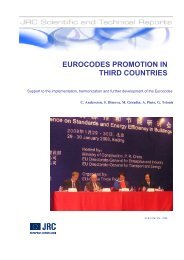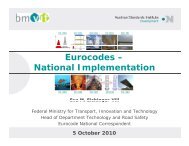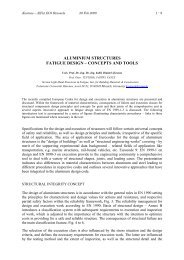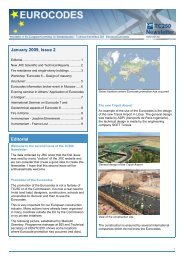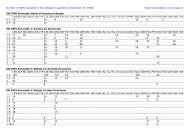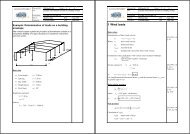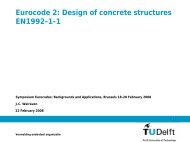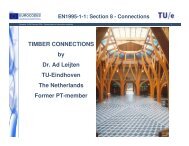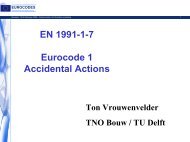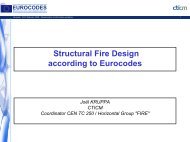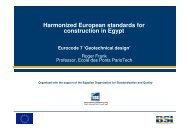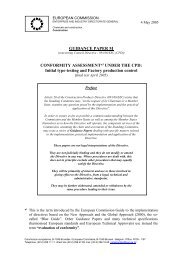Eurocodes and National Annexes (including EN 1990 and EN 1991 ...
Eurocodes and National Annexes (including EN 1990 and EN 1991 ...
Eurocodes and National Annexes (including EN 1990 and EN 1991 ...
- No tags were found...
Create successful ePaper yourself
Turn your PDF publications into a flip-book with our unique Google optimized e-Paper software.
EUROCODE 6Background <strong>and</strong> applicationsDissemination of information for training – Brussels, 2-3 April 2009 1<strong>Eurocodes</strong> <strong>and</strong> <strong>National</strong> <strong>Annexes</strong>(<strong>including</strong> <strong>EN</strong> <strong>1990</strong> <strong>and</strong> <strong>EN</strong> <strong>1991</strong>)Barry Haseltine MBE
EUROCODE 6Background <strong>and</strong> applicationsDissemination of information for training – Brussels, 2-3 April 2009 2SHORT INTRODUCTION TO <strong>EN</strong> <strong>1990</strong> AND<strong>EN</strong> <strong>1991</strong>Shortened version of presentations given toWorkshop in February 2008(excluding bridges)Grateful thanks toHaig Gulvanessian CBEFor some of the slides that are used for thispresentation
EUROCODE 6Background <strong>and</strong> applicationsEurocode SubjectsDissemination of information for training – Brussels, 2-3 April 2009 3The full list of Eurocode subjects, with the number ofParts in each is:<strong>EN</strong><strong>1990</strong> Basis of Structural Design 1 Part<strong>EN</strong><strong>1991</strong> Actions on Structures 10 Parts<strong>EN</strong>1992 Design of Concrete Structures 4 Parts<strong>EN</strong>1993 Design of Steel Structures 20 Parts<strong>EN</strong>1994 Design of Composite Structures 3 Parts<strong>EN</strong>1995 Design of Timber Structures 3 Parts<strong>EN</strong>1996 Design of Masonry Structures 4 Parts<strong>EN</strong>1997 Geotechnical Design 2 Parts<strong>EN</strong>1998 Design of Structures for Earthquake Resistance 6 Parts<strong>EN</strong>1999 Design of Aluminium Structures 5 Parts3
EUROCODE 6Background <strong>and</strong> applicationsParts of EC 6Dissemination of information for training – Brussels, 2-3 April 2009 4<strong>EN</strong> 1996: Design of masonry structures has four parts:<strong>EN</strong> 1996-1-1: Design of masonry structures – Part 1-1: Common rules for reinforced<strong>and</strong> unreinforced masonry design<strong>EN</strong> 1996-1-2: Design of masonry structures – Part 1-2: General rules – Structural firedesign<strong>EN</strong> 1996-2: Design of masonry structures – Part 2: Design considerations, selection ofmaterials <strong>and</strong> execution of masonry structures<strong>EN</strong> 1996-3: Design of masonry structures – Part 3: Simplified calculation methods forunreinforced masonry structures4
EUROCODE 6Background <strong>and</strong> applicationsPublication of a Eurocode Part<strong>and</strong> withdrawal of <strong>National</strong> CodesDissemination of information for training – Brussels, 2-3 April 2009 5NSB must publish <strong>EN</strong> Part, from <strong>EN</strong> titlepage to the last page of the <strong>Annexes</strong>(whether Informative or Normative) withoutany change whatsoever5
EUROCODE 6Background <strong>and</strong> applicationsElements of a European St<strong>and</strong>ardDissemination of information for training – Brussels, 2-3 April 2009 6ababcef<strong>National</strong> title page<strong>National</strong> foreword<strong>EN</strong> title paged <strong>EN</strong> text<strong>EN</strong> Annex(es)<strong>National</strong> annexc de6f
EUROCODE 6Background <strong>and</strong> applicationsPublication of a Eurocode Part<strong>and</strong> withdrawal of <strong>National</strong> CodesDissemination of information for training – Brussels, 2-3 April 2009 7Date of Availability (DAV) of a Eurocode PartMax 2 YearsPublication by NSB within 6 months (without <strong>National</strong> Annex)Translation intoCountry Languagefrom E, F or GFix <strong>National</strong>lyDeterminedParametersAdapt <strong>National</strong>Provisions to allowuse of Eurocode PartsPublication of <strong>National</strong> AnnexMax 3 YearsCoexistence Periodwith<strong>National</strong> CodesFinal Adaption of<strong>National</strong>ProvisionsPreparation ofDesign Aids(software, h<strong>and</strong>books)Withdrawal of <strong>National</strong> Codes having same scope as Eurocode Partby March 20107
EUROCODE 6Background <strong>and</strong> applications<strong>National</strong>ly Determined ParametersDissemination of information for training – Brussels, 2-3 April 2009 8Member States Set Safety Levelse.g Partial Safety Factors γ8
EUROCODE 6Background <strong>and</strong> applications<strong>National</strong>ly Determined ParametersDissemination of information for training – Brussels, 2-3 April 2009 9Eurocode Parts allow for <strong>National</strong> Choiceby use ofClassesSymbols instead of valuesAlternative MethodsCountry specific data9
EUROCODE 6Background <strong>and</strong> applications<strong>National</strong>ly Determined ParametersDissemination of information for training – Brussels, 2-3 April 2009 10The <strong>National</strong> Choice ofa Classvalue for a Symbolmethod where a choice is givenCountry specific dataequals<strong>National</strong>ly Determined Parameter (NDP)10
EUROCODE 6Background <strong>and</strong> applications<strong>National</strong>ly Determined ParametersDissemination of information for training – Brussels, 2-3 April 2009 11Recommended to give NDPs in <strong>National</strong><strong>Annexes</strong>, published by NSBs separately fromPartsorPermitted for NDPs to be put in Regulationsor<strong>National</strong> St<strong>and</strong>ard (separate from Part)11
EUROCODE 6Background <strong>and</strong> applications<strong>National</strong>ly Determined ParametersDissemination of information for training – Brussels, 2-3 April 2009 12Decisions on the status of Informative <strong>Annexes</strong>:The <strong>National</strong> Annex should state whether anInformative Annex may or may not be used in aCountry. If it may not, then no alternative can begiven in the <strong>National</strong> Annex, but reference canbe made to another document for example NCCI12
EUROCODE 6Background <strong>and</strong> applicationsDissemination of information for training – Brussels, 2-3 April 2009 13LINKS BETWE<strong>EN</strong> THE EUROCODES<strong>EN</strong> <strong>1990</strong>Structural safety,serviceability <strong>and</strong>durability<strong>EN</strong> <strong>1991</strong>Actions onstructures<strong>EN</strong> 1992 <strong>EN</strong> 1993 <strong>EN</strong> 1994<strong>EN</strong> 1995 <strong>EN</strong> 1996 <strong>EN</strong> 1999Design <strong>and</strong> detailing<strong>EN</strong> 1997<strong>EN</strong> 1998Geotechnical <strong>and</strong>Seismic design
EUROCODE 6Background <strong>and</strong> applicationsDissemination of information for training – Brussels, 2-3 April 2009 14<strong>EN</strong> <strong>1990</strong>: EUROCODE: BASIS OFSTRUCTURAL DESIGN<strong>EN</strong> <strong>1990</strong> is the key Eurocode for the design ofbuildings <strong>and</strong> civil engineering worksEvery Eurocode part from<strong>EN</strong> <strong>1991</strong>:Eurocode 1: Actions on Structures throughthe design <strong>Eurocodes</strong> <strong>EN</strong> 1992 to <strong>EN</strong> 1999requires the use of <strong>EN</strong> <strong>1990</strong>‣ <strong>EN</strong> <strong>1990</strong> provides the material independent <strong>and</strong>safety related information required for the design ofbuildings, <strong>and</strong> civil engineering works for the<strong>Eurocodes</strong> suite.
EUROCODE 6Background <strong>and</strong> applicationsDissemination of information for training – Brussels, 2-3 April 2009 15<strong>EN</strong> <strong>1990</strong> : EUROCODE: BASIS OFSTRUCTURAL DESIGN: CONT<strong>EN</strong>TSForewordSection 1: GeneralSection 2: RequirementsSection 3: Principles of limit statesSection 4: Basic variablesSection 5: Structural analysis <strong>and</strong> design assisted bytestingSection 6: Verification by the partial factor methodAnnex A (N): Application for buildings (1); bridges (2)Annex B (Inf): Management of structural reliability forconstruction worksAnnex C (Inf): Basis for partial factor design <strong>and</strong>reliability analysisAnnex D (Inf): Design assisted by testing
EUROCODE 6Background <strong>and</strong> applicationsDissemination of information for training – Brussels, 2-3 April 2009 16<strong>EN</strong> <strong>1990</strong>: EUROCODE BASIS OFSTRUCTURAL DESIGNObjectives of <strong>EN</strong> <strong>1990</strong>: Basis of Design<strong>EN</strong> <strong>1990</strong> establishes principles <strong>and</strong> requirementsfor the• Safety• Serviceability• Durabilityof structures; <strong>and</strong> describes• The basis for their design <strong>and</strong> verification, <strong>and</strong>• Gives guidelines for related aspects ofstructural reliability
EUROCODE 6Background <strong>and</strong> applicationsDissemination of information for training – Brussels, 2-3 April 2009 17SCOPE(1) <strong>EN</strong> <strong>1990</strong> establishes Principles <strong>and</strong> requirements for the safety,serviceability <strong>and</strong> durability of structures, describes the basis fortheir design <strong>and</strong> verification <strong>and</strong> gives guidelines for relatedaspects of structural reliability.(2) <strong>EN</strong> <strong>1990</strong> is intended to be used in conjunction with <strong>EN</strong> <strong>1991</strong> to <strong>EN</strong>1999 for the structural design of buildings <strong>and</strong> civil engineeringworks, <strong>including</strong> geotechnical aspects, structural fire design,situations involving earthquakes, execution <strong>and</strong> temporarystructures. NOTE For the design of special construction works(e.g.nuclear installations, dams, etc.), other provisions than those in<strong>EN</strong> <strong>1990</strong> to <strong>EN</strong> 1999 might be necessary.(3) <strong>EN</strong> <strong>1990</strong> is applicable for the design of structures where othermaterials or other actions outside the scope of <strong>EN</strong> <strong>1991</strong> to <strong>EN</strong> 1999are involved.(4) <strong>EN</strong> <strong>1990</strong> is applicable for the structural appraisal of existingconstruction, in developing the design of repairs <strong>and</strong> alterations orin assessing changes of use. NOTE Additional or amendedprovisions might be necessary where appropriate.
EUROCODE 6Background <strong>and</strong> applications<strong>EN</strong> <strong>1990</strong> – EUROCODE : BASIS OF STRUCTURALDESIGNDissemination of information for training – Brussels, 2-3 April 2009 181.3 Assumptions(1) Design which employs the Principles <strong>and</strong> ApplicationRules is deemed to meet the requirements provided theassumptions given in <strong>EN</strong> <strong>1990</strong> to <strong>EN</strong> 1999 are satisfied(2) The general assumptions of <strong>EN</strong> <strong>1990</strong> are :- the choice of the structural system <strong>and</strong> the design of thestructure is made by appropriately qualified <strong>and</strong>experienced personnel;- execution is carried out by personnel having theappropriate skill <strong>and</strong> experience;- adequate supervision <strong>and</strong> quality control is provided indesign offices <strong>and</strong> during execution of the work, i.e.,factories, plants, <strong>and</strong> on site;
EUROCODE 6Background <strong>and</strong> applications<strong>EN</strong> <strong>1990</strong> – EUROCODE : BASIS OF STRUCTURALDESIGNDissemination of information for training – Brussels, 2-3 April 2009 191.3 Assumptions (cont.)- the construction materials <strong>and</strong> products are used asspecified in <strong>EN</strong> <strong>1990</strong> or in <strong>EN</strong> <strong>1991</strong> to <strong>EN</strong> 1999 or in therelevant execution st<strong>and</strong>ards, or reference material orproduct specifications;- the structure will be adequately maintained;-the structure will be used in accordance with the designassumptions.
EUROCODE 6Background <strong>and</strong> applicationsDissemination of information for training – Brussels, 2-3 April 2009 20<strong>EN</strong> <strong>1990</strong> : EUROCODE: BASIS OFSTRUCTURAL DESIGNTHE REQUIREM<strong>EN</strong>TS IN <strong>EN</strong> <strong>1990</strong>• Fundamental requirements (safety;serviceability; robustness <strong>and</strong> fire)• Reliability differentiation• Design working life• Durability• Quality Assurance
EUROCODE 6Background <strong>and</strong> applicationsDissemination of information for training – Brussels, 2-3 April 2009 21The fundamental requirements in<strong>EN</strong> <strong>1990</strong> for the reliability ofconstruction works include :Structural safety: A structure shall bedesigned <strong>and</strong> executed in such a way that itwill, during its intended life with appropriatedegrees of reliability, <strong>and</strong> in an economicway sustain all actions likely to occurduring execution <strong>and</strong> use. Safety of people,the structure <strong>and</strong> contents.Serviceability: A structure shall bedesigned <strong>and</strong> executed in such a way that itwill, during its intended life with appropriatedegrees of reliability <strong>and</strong> in an economicway remain fit for the use for which it isrequired. Functioning, comfort <strong>and</strong>appearance of the structure
EUROCODE 6Background <strong>and</strong> applicationsDissemination of information for training – Brussels, 2-3 April 2009 22The fundamentalrequirements in <strong>EN</strong> <strong>1990</strong> forthe reliability of constructionworks include :Robustness: A structureshall be designed <strong>and</strong> executedin such a way that it will not bedamaged by events such as• Explosions• Impact <strong>and</strong>• Consequences of humanerrorsExplosion atRonan Point1968to an extent disproportionate tothe original causeNote: The events to be takeninto account are those agreedfor an individual project withthe client <strong>and</strong> the relevantauthority
EUROCODE 6Background <strong>and</strong> applicationsDissemination of information for training – Brussels, 2-3 April 2009 23<strong>EN</strong> <strong>1990</strong> : EUROCODE: BASIS OFSTRUCTURAL DESIGNTHE REQUIREM<strong>EN</strong>TS IN <strong>EN</strong> <strong>1990</strong>• Fundamental requirements (safety;serviceability; robustness <strong>and</strong> fire)• Reliability differentiation• Design working life• Durability• Quality Assurance
EUROCODE 6Background <strong>and</strong> applicationsDissemination of information for training – Brussels, 2-3 April 2009 24<strong>EN</strong> <strong>1990</strong>: EUROCODE: BASIS OFSTRUCTURAL DESIGNReliability DifferentiationThe choice of the levels of reliability for a particularstructure should take account of the relevant factors,<strong>including</strong> :• the possible cause <strong>and</strong> /or mode of attaining a limit state;• the possible consequences of failure in terms of risk to life,injury, potential economical losses;• public perception of failure;• the expense <strong>and</strong> procedures necessary to reduce the risk offailure.
EUROCODE 6Background <strong>and</strong> applicationsDissemination of information for training – Brussels, 2-3 April 2009 25<strong>EN</strong> <strong>1990</strong>: DEFINITION OF CONSEQU<strong>EN</strong>CE CLASSESConsequenceClassDescriptionExamples of buildings <strong>and</strong>civil engineering worksCC3CC2High consequence for loss of human life,or economic, social or environmentalconsequences very greatMedium consequence for loss of humanlife, economic, social or environmentalconsequences considerableGr<strong>and</strong>st<strong>and</strong>s, bridges, publicbuildings whereconsequences of failure arehigh (e.g. a concert hall)Residential <strong>and</strong> officebuildings, public buildingswhere consequences offailure are medium (e.g. anoffice building)CC1Low consequence for loss of human life,<strong>and</strong> economic, social or environmentalconsequences small or negligibleAgricultural buildings wherepeople do not normally enter(e.g. for storage),greenhouses
EUROCODE 6Background <strong>and</strong> applicationsDissemination of information for training – Brussels, 2-3 April 2009 26<strong>EN</strong> <strong>1990</strong>: TOOLS FOR THE MANAGEM<strong>EN</strong>T OFSTRUCTURAL RELIABILITYDepending upon the consequences of failure, the maintools selected in <strong>EN</strong><strong>1990</strong> Annex B (Informative) for themanagement of structural reliability of construction worksare:• differentiation by β (reliability index) values; at thisstage, this is a specialist activity;• modification of partial factors;• design supervision differentiation;• inspection during execution
EUROCODE 6Background <strong>and</strong> applicationsDissemination of information for training – Brussels, 2-3 April 2009 27<strong>EN</strong> <strong>1990</strong> : EUROCODE: BASIS OFSTRUCTURAL DESIGNTHE REQUIREM<strong>EN</strong>TS IN <strong>EN</strong> <strong>1990</strong>• Fundamental requirements (safety;serviceability; robustness <strong>and</strong> fire)• Reliability differentiation• Design working life• Durability• Quality Assurance
EUROCODE 6Background <strong>and</strong> applicationsDissemination of information for training – Brussels, 2-3 April 2009 28The requirement for designworking life states :The design working life is theassumed period for which astructure is to be used for itsintended purpose with anticipatedmaintenance but without majorrepair being necessarya design working life of• 50 years for buildings• 100 years for bridges <strong>and</strong>is recommended in <strong>EN</strong> <strong>1990</strong>.
EUROCODE 6Background <strong>and</strong> applicationsDissemination of information for training – Brussels, 2-3 April 2009 29<strong>EN</strong> <strong>1990</strong> – INDICATIVE DESIGN WORKING LIFEDesignworking lifecategorydesign workingIndicative life(years)Examples1 10 Temporary structures (1)2 10 to 25 Replaceable structural parts, e.g. gantrygirders, bearings3 15 to 30 Agricultural <strong>and</strong> similar structures4 50 Building structures <strong>and</strong> other commonstructures, not listed elsewhere in this table5 100 Monumental building structures, highway <strong>and</strong>railway bridges, <strong>and</strong> other civil engineeringstructures(1) Structures or parts of structures that can be dismantled with a view ofbeing re-used should not be considered as temporary
EUROCODE 6Background <strong>and</strong> applicationsDissemination of information for training – Brussels, 2-3 April 2009 30<strong>EN</strong> <strong>1990</strong> : EUROCODE: BASIS OFSTRUCTURAL DESIGNTHE REQUIREM<strong>EN</strong>TS IN <strong>EN</strong> <strong>1990</strong>• Fundamental requirements (safety;serviceability; robustness <strong>and</strong> fire)• Reliability differentiation• Design working life• Durability• Quality Assurance
EUROCODE 6Background <strong>and</strong> applicationsDissemination of information for training – Brussels, 2-3 April 2009 31ULTIMATE LIMIT-STATE :• the safety of thestructure• the safety of people• In specialcircumstances theprotection of thecontents• loss of equilibrium of the structure orany part of it, considered as a rigidbody• failure by excessive deformation,transformation of the structure or anypart of it into a mechanism, rupture,loss of stability of the structure or anypart of it, <strong>including</strong> supports <strong>and</strong>foundations• failure caused by fatigue or othertime-dependent effectsSERVICEABILITY LIMIT-STATE• Functioning of the structure or structuralmembers under normal use,• comfort of people,• appearance of construction works
EUROCODE 6Background <strong>and</strong> applicationsDissemination of information for training – Brussels, 2-3 April 2009 32<strong>EN</strong> <strong>1990</strong>: EUROCODE: BASIS OFSTRUCTURAL DESIGNDesign SituationsDesign situations are classified in <strong>EN</strong> <strong>1990</strong> as follows:• persistent design situations, which refer to the conditions ofnormal use• accidental design situations, which refer to exceptionalconditions applicable to the structure or to its exposure, e.g. tofire, explosion, impact or the consequences of localised failure• seismic design situations, which refer to conditions applicableto the structure when subjected to seismic events• transient design situations which refer to temporary conditionsapplicable to the structure, e.g. during execution or repair
EUROCODE 6Background <strong>and</strong> applicationsDissemination of information for training – Brussels, 2-3 April 2009 33<strong>EN</strong><strong>1990</strong> : EUROCODE: BASIS OFSTRUCTURAL DESIGNVerifications of static equilibrium <strong>and</strong> resistanceIndividual verifications are performedUltimate limit states of static equilibrium (EQU):E d,dst≤ E d,stbUltimate limit states of resistance (STR/GEO):E d ≤ R d
EUROCODE 6Background <strong>and</strong> applicationsDissemination of information for training – Brussels, 2-3 April 2009 34<strong>EN</strong><strong>1990</strong> : EUROCODE: BASIS OF STRUCTURALDESIGNUltimate limit states
EUROCODE 6Background <strong>and</strong> applicationsDissemination of information for training – Brussels, 2-3 April 2009 35<strong>EN</strong><strong>1990</strong> : EUROCODE: BASIS OF STRUCTURALDESIGNUltimate limit states of STR/GEO - Fundamental combinationfor persistent <strong>and</strong> transient design situations∑Expression (6.10)∑γG , jGk, j"+ " γPP"+ " γQ ,1Qk,1"+ "j≥ 1 i>1⎧⎪⎨⎪⎩Expressions (6.10a) <strong>and</strong> (6.10b)∑j≥1∑j≥1γξG,jjγGG,jk , jG" + " γk , j0,85 ≤ ξ ≤ 1,00P" + " γP"+ "P∑i≥1P"+ " γγQ,iQ,1ψQ0, ik ,1Qk , i" + "γ∑i>1Q , iγψQ,i0, iψQ0, ik , iQk , i
EUROCODE 6Background <strong>and</strong> applications<strong>EN</strong> <strong>1990</strong> - ULS Verification (Persistent <strong>and</strong> TransientDesign Situation)Dissemination of information for training – Brussels, 2-3 April 2009 36E d ≤ R dApplying Equation 6.10 from <strong>EN</strong><strong>1990</strong>:E d = E { Σ j≥1 γ G,j G k,j “+” γ p P “+” γ Q,1 Q k,1 “+” Σ i>1 γ Q,i ψ 0,i Q k,i }
EUROCODE 6Background <strong>and</strong> applications<strong>EN</strong> <strong>1990</strong> - ULS Verification (Persistent <strong>and</strong> TransientDesign Situation)Dissemination of information for training – Brussels, 2-3 April 2009 37DesigneffectE d = E { Σ j≥1 γ G,j G k,j “+” γ p P “+” γ Q,1 Q k,1 “+” Σ i>1 γ Q,i ψ 0,i Q k,i }
EUROCODE 6Background <strong>and</strong> applications<strong>EN</strong> <strong>1990</strong> - ULS Verification (Persistent <strong>and</strong> TransientDesign Situation)Dissemination of information for training – Brussels, 2-3 April 2009 38DesigneffectE d = E { Σ j≥1 γ G,j G k,j “+” γ p P “+” γ Q,1 Q k,1 “+” Σ i>1 γ Q,i ψ 0,i Q k,i }Effect of
EUROCODE 6Background <strong>and</strong> applications<strong>EN</strong> <strong>1990</strong> - ULS Verification (Persistent <strong>and</strong> TransientDesign Situation)Dissemination of information for training – Brussels, 2-3 April 2009 39DesigneffectPermanentactionsE d = E { Σ j≥1 γ G,j G k,j “+” γ p P “+” γ Q,1 Q k,1 “+” Σ i>1 γ Q,i ψ 0,i Q k,i }Effect of
EUROCODE 6Background <strong>and</strong> applications<strong>EN</strong> <strong>1990</strong> - ULS Verification (Persistent <strong>and</strong> TransientDesign Situation)Dissemination of information for training – Brussels, 2-3 April 2009 40DesigneffectPermanentactionsE d = E { Σ j≥1 γ G,j G k,j “+” γ p P “+” γ Q,1 Q k,1 “+” Σ i>1 γ Q,i ψ 0,i Q k,i }Effect ofCombinedwith
EUROCODE 6Background <strong>and</strong> applications<strong>EN</strong> <strong>1990</strong> - ULS Verification (Persistent <strong>and</strong> TransientDesign Situation)Dissemination of information for training – Brussels, 2-3 April 2009 41DesigneffectPermanentactionsE d = E { Σ j≥1 γ G,j G k,j “+” γ p P “+” γ Q,1 Q k,1 “+” Σ i>1 γ Q,i ψ 0,i Q k,i }Effect ofPrestressCombinedwith
EUROCODE 6Background <strong>and</strong> applications<strong>EN</strong> <strong>1990</strong> - ULS Verification (Persistent <strong>and</strong> TransientDesign Situation)Dissemination of information for training – Brussels, 2-3 April 2009 42DesigneffectPermanentactionsLeadingvariableactionE d = E { Σ j≥1 γ G,j G k,j “+” γ p P “+” γ Q,1 Q k,1 “+” Σ i>1 γ Q,i ψ 0,i Q k,i }Effect ofPrestressCombinedwith
EUROCODE 6Background <strong>and</strong> applications<strong>EN</strong> <strong>1990</strong> - ULS Verification (Persistent <strong>and</strong> TransientDesign Situation)Dissemination of information for training – Brussels, 2-3 April 2009 43DesigneffectPermanentactionsLeadingvariableactionE d = E { Σ j≥1 γ G,j G k,j “+” γ p P “+” γ Q,1 Q k,1 “+” Σ i>1 γ Q,i ψ 0,i Q k,i }Effect ofCombinedwithPrestressAccompanyingvariableactions
EUROCODE 6Background <strong>and</strong> applications<strong>EN</strong> <strong>1990</strong> - ULS Verification -Where do parameters come fromDissemination of information for training – Brussels, 2-3 April 2009 44<strong>EN</strong><strong>1990</strong>Annex A (i.e. A1 or A2)E d = E { Σ j≥1 γ G,j G k,j “+” γ p P “+” γ Q,1 Q k,1 “+” Σ i>1 γ Q,i ψ 0,i Q k,i }<strong>EN</strong>1992-<strong>EN</strong>1997may giverulesDefined inrelevantEurocode<strong>EN</strong><strong>1991</strong>(<strong>EN</strong>1997)
EUROCODE 6Background <strong>and</strong> applicationsDissemination of information for training – Brussels, 2-3 April 2009 45Annex A –Normative- of <strong>EN</strong> <strong>1990</strong>gives the partial factors <strong>and</strong> psi factors for use inbuildings <strong>and</strong> bridgesAnnex A1 Buildings <strong>and</strong>A2 Bridges (introduced by amendment no 1)Of course such vital information as the partialfactors for loads appears in the form of symbols,with recommended values.Each Country has to choose these factors as NDPs.
EUROCODE 6Background <strong>and</strong> applicationsDissemination of information for training – Brussels, 2-3 April 2009 46<strong>EN</strong><strong>1990</strong> - EUROCODE : BASIS OFSTRUCTURAL DESIGNAccidental design situations : expression 6.11b∑∑Gk, j"+ " P"+ " Ad" + "( ψ1,1orψ2,1)Qk,1"+ "j≥ 1 i>1ψ2, iQk , iSeismic design situations : expression 6.12b∑G " + " P"+ " A " + ",∑k jEdj≥ 1 i>1ψ2, iQk,i
EUROCODE 6Background <strong>and</strong> applicationsDissemination of information for training – Brussels, 2-3 April 2009 47Serviceability limit statesIt shall be verified that :where :<strong>EN</strong><strong>1990</strong> : EUROCODE: BASIS OFSTRUCTURAL DESIGNE d≤ C d(6.13)C d is the limiting design value of the relevant serviceability criterionE dis the design value of the effects of actions specified in theserviceability criterion, determined on the basis of the relevantcombination
EUROCODE 6Background <strong>and</strong> applicationsDissemination of information for training – Brussels, 2-3 April 2009 48<strong>EN</strong><strong>1990</strong> : BASIS OF STRUCTURAL DESIGNServiceability limit states : combinations of actionsCharacteristic Combination (irreversible SLS)∑Frequent Combination (reversible SLS)Quasi-permanent Combination (reversible SLS)∑Gk, j"+ " P"+ " Qk,1"+ "j≥ 1 i>1∑ψ∑Gk, j"+ " P"+ " ψ1,1Qk,1"+ "j≥ 1 i>1∑∑Gk, j"+ " P"+ "j≥1 i≥1ψ2, i0, iQψQ2, ik , ik , iQk , i
EUROCODE 6Background <strong>and</strong> applicationsDissemination of information for training – Brussels, 2-3 April 2009 49EUROCODE <strong>1991</strong>Actions
EUROCODE 6Background <strong>and</strong> applicationsDissemination of information for training – Brussels, 2-3 April 2009 50<strong>EN</strong> <strong>1991</strong> Actions on StructuresPart 1-1 Densities, self-weight <strong>and</strong> imposed loadsPart 1-2 Actions on structures exposed to firePart 1-3 Snow LoadsPart 1-4 Wind actionsPart 1-5 Thermal actionsPart 1-6 Actions during executionPart 1-7 Accidental actionsPart 2 Traffic loads on bridgesPart 3 Actions induced by cranes <strong>and</strong> machineryPart 4 Actions in silos <strong>and</strong> tanks
EUROCODE 6Background <strong>and</strong> applicationsDissemination of information for training – Brussels, 2-3 April 2009 51<strong>EN</strong> <strong>1991</strong> Actions on StructuresPart 1-1 Densities, self-weight <strong>and</strong> imposed loadsPart 1-2 Actions on structures exposed to firePart 1-3 Snow LoadsPart 1-4 Wind actionsPart 1-5 Thermal actionsPart 1-6 Actions during executionPart 1-7 Accidental actionsPart 2 Traffic loads on bridgesPart3 Actions induced by cranes <strong>and</strong> machineryPart4 Actions in silos <strong>and</strong> tanks
EUROCODE 6Background <strong>and</strong> applicationsDissemination of information for training – Brussels, 2-3 April 2009 52<strong>EN</strong> <strong>1991</strong> Actions on StructuresPart 1-1 Densities, self-weight <strong>and</strong> imposed loadsPart 1-2 Actions on structures exposed to firePart 1-3 Snow LoadsPart 1-4 Wind actionsPart 1-5 Thermal actionsPart 1-6 Actions during executionPart 1-7 Accidental actionsPart 2 Traffic loads on bridgesPart3 Actions induced by cranes <strong>and</strong> machineryPart4 Actions in silos <strong>and</strong> tanks
EUROCODE 6Background <strong>and</strong> applicationsDissemination of information for training – Brussels, 2-3 April 2009 53EUROCODE <strong>1991</strong>Most Parts of the Series of Codes onActions are frameworksAlmost all values will have to bedetermined <strong>National</strong>ly
EUROCODE 6Background <strong>and</strong> applications<strong>EN</strong> <strong>1991</strong>-1-1: ContentsDissemination of information for training – Brussels, 2-3 April 2009 54ForewordSection 1 GeneralSection 2 Classification Of ActionsSection 3 Design SituationsSection 4 Densities Of Construction And StoredMaterialsSection 5 Self-weight Of Construction WorksSection 6 Imposed Loads On BuildingsAnnex A (Informative) Tables For Nominal DensityOf Construction Materials, And Nominal DensityAnd Angles Of Repose For Stored MaterialsAnnex B (Informative) Vehicle Barriers AndParapets For Car ParksN.B. imposed loads due to occupancy <strong>and</strong>maintenance are given only in <strong>EN</strong> <strong>1991</strong>-1-1(unlike BS6399 Part 3). Snow Loads on roofs aregiven in BS <strong>EN</strong> <strong>1991</strong>-1-3
EUROCODE 6Background <strong>and</strong> applications<strong>EN</strong> <strong>1991</strong>-1-1: Classification of ActionsDissemination of information for training – Brussels, 2-3 April 2009 55Self-weight of construction works:generally a Permanent Fixed action,If Free (e.g. moveable partitions) then treatas an additional imposed load.Ballast <strong>and</strong> earth loads on roofs/terraces:Permanent with variations in properties(moisture content, depth) during thedesign life being taken into account.If Variable with time then represented byupper <strong>and</strong> lower characteristic values,<strong>and</strong>
EUROCODE 6Background <strong>and</strong> applications<strong>EN</strong> <strong>1991</strong>-1-1: Classification of ActionsDissemination of information for training – Brussels, 2-3 April 2009 56Imposed loads on buildings:generally Variable Fixed or Variable Free actionsImposed loads generally quasi-static <strong>and</strong> allow for smalldynamic effects in static structures. When dynamicresponse possible, a dynamic analysis isrecommended as per the <strong>National</strong> AnnexActions causing significant acceleration of structuralmembers are classified as dynamic <strong>and</strong> need to beconsidered via a dynamic analysisFor fork-lift trucks <strong>and</strong> helicopters additional inertialloads from hoisting <strong>and</strong> take-off/l<strong>and</strong>ing areaccounted for through a dynamic magnification factorapplied to appropriate static load values
EUROCODE 6Background <strong>and</strong> applications<strong>EN</strong> <strong>1991</strong>-1-1: Densities of construction <strong>and</strong> storedmaterialsDissemination of information for training – Brussels, 2-3 April 2009 57Characteristic values of densities ofconstruction <strong>and</strong> stored materials shouldgenerally be used in the expressions forcombination of actions.Where only mean values available, theyshould be taken as characteristic valuesin the design. Mean values for a largenumber of different materials are given in<strong>EN</strong> <strong>1991</strong>-1-1 Annex A.
EUROCODE 6Background <strong>and</strong> applications<strong>EN</strong> <strong>1991</strong>-1-1: Self-weight of construction worksDissemination of information for training – Brussels, 2-3 April 2009 58Self-weight is generally represented by a singlecharacteristic value calculated from nominaldimensions, characteristic values of densities<strong>and</strong> <strong>including</strong>, where appropriate, ancillaryelements, e.g. non-structural elements <strong>and</strong> fixedservices, weight of earth <strong>and</strong> ballast.
EUROCODE 6Background <strong>and</strong> applications<strong>EN</strong> <strong>1991</strong>-1-1: Imposed loads on buildingsDissemination of information for training – Brussels, 2-3 April 2009 59Characteristic values of loads for floors <strong>and</strong>roofs for the following types of occupancy <strong>and</strong>use:residential, social, commercial <strong>and</strong> administrationareasgarage <strong>and</strong> vehicle trafficareas for storage <strong>and</strong> industrial activitiesroofshelicopter l<strong>and</strong>ing areasbarriers <strong>and</strong> walls having the function of barriers.
EUROCODE 6Background <strong>and</strong> applications<strong>EN</strong> <strong>1991</strong>-1-1: Imposed loads on buildingsDissemination of information for training – Brussels, 2-3 April 2009 60Loads arise due to occupancy <strong>and</strong> the values given in <strong>EN</strong> <strong>1991</strong>-1-1account fornormal use by personsfurniture <strong>and</strong> moveable objects,vehiclesrare events such as concentrations of people <strong>and</strong> furniture duringtimes of re-organisation <strong>and</strong> refurbishmentFloor <strong>and</strong> roof areas in buildings are sub-divided into 11 categoriesaccording to use; loads specified are represented by uniformlydistributed loads (UDL), concentrated loads, line loads orcombinations thereof.Heavy equipment such as may be found in communal kitchens orboiler rooms are specifically excluded from <strong>EN</strong> <strong>1991</strong>-1-1. Need to beagreed with the Client <strong>and</strong> the relevant Authority for specificprojects.
EUROCODE 6Background <strong>and</strong> applications<strong>EN</strong> <strong>1991</strong>-1-1: Imposed loads on buildingsDissemination of information for training – Brussels, 2-3 April 2009 61Table 6.1 – Categories of useCategory Specific use ExampleA Areas for domestic <strong>and</strong>residential activitiesRooms in residential buildings <strong>and</strong> houses;bedrooms <strong>and</strong> wards in hospitals;bedrooms in hotels <strong>and</strong> hostels kitchens <strong>and</strong> toilets.Table 6.1 – Categories of useCategory Specific use ExampleA Areas for domestic congregate <strong>and</strong> Rooms in (with residential the buildings <strong>and</strong> houses;residential activitiesexceptionbedroomsof<strong>and</strong>areaswards indefinedhospitals;bedrooms in hotels <strong>and</strong> hostels kitchens <strong>and</strong> toilets.under category A, B <strong>and</strong>B Office areasCB Office areasCAreas where people maycongregate (with theexception of areas definedunder category A, B <strong>and</strong>D 1) )C1: Areas with tables, etce.g. areas in schools, cafes, restaurants, dining halls, readingrooms, receptionsC2: Areas with fixed seats,e.g. areas in churches, theatres or cinemas, conference rooms,lecture halls, assembly halls, waiting rooms, railway waiting rooms.C3: Areas without obstacles for moving people, e.g. areas inmuseums, exhibition rooms, etc. <strong>and</strong> access areas in public <strong>and</strong>administration buildings, hotels, hospitals, railway station forecourtsC4:Areas with possible physical activities,e.g. dance halls, gymnastic rooms, stages .D Shopping areas D1: Areas in general retail shopsC5:Areas susceptible to large crowds, e.g. in buildings for publicevents like concert halls, sports halls <strong>including</strong> st<strong>and</strong>s, terraces <strong>and</strong>access areas <strong>and</strong> railway platforms.D2: Areas in department stores.1) Attention is drawn to 6.3.1.1(2), in particular for C4 <strong>and</strong> C5. See <strong>EN</strong> <strong>1990</strong> when dynamic effects need to beconsidered. For Category E, see Table 6.3NOTE 1. Depending on their anticipated uses, areas likely to be categorised as C2, C3, C4 may becategorised as C5 by decision of the client <strong>and</strong>/or <strong>National</strong> annex.NOTE 2. The <strong>National</strong> annex may provide sub categories to A, B, C1 to C5, D1 <strong>and</strong> D2NOTE 3. See 6.3.2 for storage or industrial activityAreas where people mayD 1) )C1: Areas with tables, etce.g. areas in schools, cafes, restaurants, dining halls, readingrooms, receptionsC2: Areas with fixed seats,e.g. areas in churches, theatres or cinemas, conference rooms,lecture halls, assembly halls, waiting rooms, railway waiting rooms.C3: Areas without obstacles for moving people, e.g. areas inmuseums, exhibition rooms, etc. <strong>and</strong> access areas in public <strong>and</strong>administration buildings, hotels, hospitals, railway station forecourtsC4:Areas with possible physical activities,e.g. dance halls, gymnastic rooms, stages .D Shopping areas D1: Areas in general retail shopsC5:Areas susceptible to large crowds, e.g. in buildings for publicevents like concert halls, sports halls <strong>including</strong> st<strong>and</strong>s, terraces <strong>and</strong>access areas <strong>and</strong> railway platforms.D2: Areas in department stores.1) Attention is drawn to 6.3.1.1(2), in particular for C4 <strong>and</strong> C5. See <strong>EN</strong> <strong>1990</strong> when dynamic effects need to beconsidered. For Category E, see Table 6.3NOTE 1. Depending on their anticipated uses, areas likely to be categorised as C2, C3, C4 may becategorised as C5 by decision of the client <strong>and</strong>/or <strong>National</strong> annex.NOTE 2. The <strong>National</strong> annex may provide sub categories to A, B, C1 to C5, D1 <strong>and</strong> D2NOTE 3. See 6.3.2 for storage or industrial activity
EUROCODE 6Background <strong>and</strong> applicationsImposed loads on buildings – Loads for floors etcDissemination of information for training – Brussels, 2-3 April 2009 62Table 6.2 – Imposed loads on floors, balconies <strong>and</strong> stairs in buildingsCategories of loaded areasq k[kN/m 2 ]Category A- Floors- Stairs- Balconies1,5 to 2,02,0 to 4,02,5 to 4,0Q k[kN]2,0 to 3,02,0 to 4,02,0 to 3,0Category BCategory C- C1- C2- C3- C4- C52,0 to 3,02,0 to 3,03,0 to 4,03,0 to 5,04,5 to 5,05,0 to 7,51, 5 to 4,53,0 to 4,02,5 to 7,0 (4,0)4,0 to 7,03,5 to 7,03,5 to 4,5Category D-D1-D24,0 to 5,04,0 to 5,03,5 to 7,0 (4,0)3,5 to 7,0NOTE: Where a range is given in this table, the value may be set by the <strong>National</strong> annex. Therecommended values, intended for separate application, are underlined. q k is intended for thedetermination of general effects <strong>and</strong> Q k for local effects. The <strong>National</strong> annex may define differentconditions of use of this Table.
EUROCODE 6Background <strong>and</strong> applicationsLoad arrangements <strong>EN</strong> <strong>1990</strong> & <strong>EN</strong> <strong>1991</strong>-1-1Dissemination of information for training – Brussels, 2-3 April 2009 63Mid span bending moment of a floor structureChess board arrangement Simplification in <strong>EN</strong> <strong>1991</strong>-1-1
EUROCODE 6Background <strong>and</strong> applications<strong>EN</strong> <strong>1991</strong>-1-1: Imposed loads on buildingsDissemination of information for training – Brussels, 2-3 April 2009 64Main Categories of UseResidential, social, commercial <strong>and</strong> administrationareas- 4 categories (A, B, C <strong>and</strong> D)Areas for storage <strong>and</strong> industrial activities- 2 categories (E1 <strong>and</strong> E2)Garages <strong>and</strong> vehicle traffic (excluding bridges)- 2 categories (F <strong>and</strong> G)Roofs- 3 categories (H, I <strong>and</strong> K)
EUROCODE 6Background <strong>and</strong> applications<strong>EN</strong> <strong>1991</strong>-1-1: Imposed loads on buildingsDissemination of information for training – Brussels, 2-3 April 2009 65RoofsCategory H – Accessible for normal maintenance<strong>and</strong> repair onlyCategory I – Accessible with occupancy accordingto categories A to GCategory K – Accessible for special services e.g.helicopter l<strong>and</strong>ing areas
EUROCODE 6Background <strong>and</strong> applications<strong>EN</strong> <strong>1991</strong>-1-1: ANNEX A: Table A.1 - Constructionmaterials-concrete <strong>and</strong> mortarDissemination of information for training – Brussels, 2-3 April 2009 66concrete (see <strong>EN</strong> 206)lightweightdensity class LC 1,0density class LC 1,2density class LC 1,4density class LC 1,6density class LC 1,8density class LC 2,0normal weightheavy weightmortarcement mortargypsum mortarlime-cement mortarlime mortarMaterialsDensityγ[kN/m 3 ]9,0 to 10,0 1)2)10,0 to 12,0 1)2)12,0 to 14,0 1)2)14,0 to 16,0 1)2)16,0 to 18,0 1)2)18,0 to 20,0 1)2)24,0 1)2)> 1)2)19,0 to 23,012,0 to 18,018,0 to 20,012,0 to 18,01)Increase by 1kN/m 3 for normal percentage of reinforcing <strong>and</strong> pre-stressing steel2)Increase by 1kN/m 3 for unhardened concreteNOTE See Section 4
EUROCODE 6Background <strong>and</strong> applications<strong>EN</strong> <strong>1991</strong>-1-1: ANNEX A: Table A.12 - Stored products -industrial <strong>and</strong> generalDissemination of information for training – Brussels, 2-3 April 2009 67Productsbooks <strong>and</strong> documentsbooks <strong>and</strong> documents,densely storedfiling racks <strong>and</strong> cabinetsgarments <strong>and</strong> rags, bundledice, lumpsleather, piledpaperin rollspiledrubberrock saltsaltsawdustdry, baggeddry, loosewet, loosetar, bitumenNOTE See Section 4.Densityγ[kN/m 3 ]6,08,56,011,08,510,015,011,010,0 to 17,022,012,03,02,55,014,0Angleof reposeφ[°]----------4540-4545-
EUROCODE 6Background <strong>and</strong> applications<strong>EN</strong> <strong>1991</strong>-1-3 – Field of applicationDissemination of information for training – Brussels, 2-3 April 2009 68<strong>EN</strong> <strong>1991</strong>-1-3 provides guidance for thedetermination of the snow load to be used forthe structural design of buildings <strong>and</strong> civil worksfor sites at altitudes under 1500m.
EUROCODE 6Background <strong>and</strong> applications<strong>EN</strong> <strong>1991</strong>-1-3 – Field of applicationDissemination of information for training – Brussels, 2-3 April 2009 69<strong>EN</strong> <strong>1991</strong>-1-3 does not give guidance on specialistaspects of snow loading, for example:“impact snow loads” resulting from snow sliding off orfalling from a higher roof;the additional wind loads which could result from changesin shape or size of the building structure due to thepresence of snow or the accretion of ice;loads in areas where snow is present all the year;ice loading;lateral loading due to snow (e.g. lateral loads exerted bydrifts).
EUROCODE 6Background <strong>and</strong> applications<strong>EN</strong> <strong>1991</strong>-1-3 - ContentsDissemination of information for training – Brussels, 2-3 April 2009 70ForewordSection 1: GeneralSection 2: Classification of actionsSection 3: Design situationsSection 4: Snow load on the groundSection 5: Snow load on roofsSection 6: Local effectsANNEX A: Design situations <strong>and</strong> load arrangements tobe used for different locationsANNEX B: Snow load shape coefficients for exceptionalsnow driftsANNEX C: European Ground Snow Load MapsANNEX D: Adjustment of the ground snow loadaccording to return periodANNEX E: Bulk weight density of snow
EUROCODE 6Background <strong>and</strong> applications<strong>EN</strong> <strong>1991</strong>-1-3 – Determination of Imposed roof snowloadsDissemination of information for training – Brussels, 2-3 April 2009 71Characteristic ground snow loads• Ground snow load map• Altitude functionCoefficients• Shape coefficient – Roof shape• Exposure coefficient – Topography• Thermal coefficient – Thermal transmittance of roofing material
EUROCODE 6Background <strong>and</strong> applicationsEC funded European snow research programme fordevelopment of <strong>EN</strong> <strong>1991</strong>-1-3Dissemination of information for training – Brussels, 2-3 April 2009 72Characteristic Snow Loads on the GroundDevelopment of a Ground Snow Load Map for EuropeThere were inconsistencies at borders between existingnational mapsThe research developed a consistent approachProduced regional maps. These are given in Annex C of<strong>EN</strong> <strong>1991</strong>-1-3• Snow load with Altitude relationship• Zone numbers & altitude function• Geographical boundaries
EUROCODE 6Background <strong>and</strong> applicationsGround Snow load map European ClimaticRegions: Member States presently coveredDissemination of information for training – Brussels, 2-3 April 2009 73Proposal being prepared to extend map to cover thewhole of Europe
EUROCODE 6Background <strong>and</strong> applicationsUndriftedSnow load on roofsDissemination of information for training – Brussels, 2-3 April 2009 74
EUROCODE 6Background <strong>and</strong> applicationsDrifted Snow on RoofDissemination of information for training – Brussels, 2-3 April 2009 75With wind speeds in the range of 4 to 5 m/s, much of thesnow is deposited in areas of ’aerodynamic shade’DRIFTED SNOW LOAD ARRANGEM<strong>EN</strong>TAerodynamicshadewind windModel in wind tunnelwind velocity of 4m/s
EUROCODE 6Background <strong>and</strong> applicationsBackground to <strong>EN</strong><strong>1991</strong>-1-4Dissemination of information for training – Brussels, 2-3 April 2009 76Wind speed is measured<strong>and</strong> modelled differentlythroughout EuropeDifferent wind climates inEurope?
EUROCODE 6Background <strong>and</strong> applicationsMajor areas of disagreement - <strong>National</strong> ChoiceDissemination of information for training – Brussels, 2-3 April 2009 77Impossible to get consensus on all parts of <strong>EN</strong><strong>1991</strong>-1-4There are 47 clauses or Notes where a recommendedprocedure is given but where <strong>National</strong> Choice is allowed,plus six informative annexesIt is expected that Member States will adopt therecommended procedures in most cases, except whereissues of safety or economy arise
EUROCODE 6Background <strong>and</strong> applications<strong>EN</strong><strong>1991</strong>-1-4: - Contents ListDissemination of information for training – Brussels, 2-3 April 2009 78Section 1 GeneralSection 2 Design situationsSection 3 Modelling of wind actionsSection 4 Wind velocity <strong>and</strong> velocity pressureSection 5 Wind actionsSection 6 Structural factor c s c dSection 7 Pressure <strong>and</strong> force coefficientsSection 8 Wind actions on bridgesAnnex A (informative) Terrain effectsAnnex B (informative) Procedure 1 for structural factor c s c dAnnex C (informative) Procedure 2 for structural factor c s c dAnnex D (informative) Graphs of c s c d for common buildingformsAnnex E (informative) Vortex shedding & aeroelasticinstabilitiesAnnex F (informative) Dynamic characteristics ofstructures
EUROCODE 6Background <strong>and</strong> applicationsSection 3 - Modelling of wind actionsDissemination of information for training – Brussels, 2-3 April 2009 79Description of wind actions (internal pressures,external pressures, forces <strong>and</strong> friction forces,dynamic response)Classification of wind action as variable fixedactionsDefinition of characteristic values
EUROCODE 6Background <strong>and</strong> applicationsSection 4: Wind velocity <strong>and</strong> velocity pressureDissemination of information for training – Brussels, 2-3 April 2009 80Basic wind velocity v b = c dir c season v b,0 c probwherev b,0 = 10 minute mean velocity at 10m above ground (z 0 = 0.05) (tc II)c dir = directional factorc season = seasonal factorc prob = probability factor<strong>National</strong> choiceallowedMean wind velocityv m (z) = c r (z) c o (z) v bwhere c r (z) = roughness factor = k r ln(z/z o )k r = terrain factor depending on z oc 0 (z) = orography (i.e. topography) factor
EUROCODE 6Background <strong>and</strong> applicationsWind Pressure <strong>and</strong> Pressure CoefficientsDissemination of information for training – Brussels, 2-3 April 2009 81External wind pressurewe=cpe⋅q(z)w ep eexternal pressure coefficient)Internal wind pressurewi=cpi⋅ q(zwp iiinternal pressure coefficientc pe depends on thesizeof the consideredelement
EUROCODE 6Background <strong>and</strong> applications<strong>EN</strong> <strong>1991</strong>-1-7: Accidental Actions: ContentsDissemination of information for training – Brussels, 2-3 April 2009 82ForewordSection 1 GeneralSection 2 Classification of actionsSection 3 Design situationsSection 4 ImpactSection 5 Internal ExplosionsAnnex A (Informative) Design for Consequences ofLocalised Failure in a building Structure from anUnspecified CauseAnnex B (Informative) Information on RiskAssessmentAnnex C (Informative) Dynamic design for impactAnnex D (Informative) Internal explosions
Professor Haig GulvanessianExamplesofaccidentalactions <strong>and</strong>situationsEUROCODE 6Background <strong>and</strong> applicationsDissemination of information for training – Brussels, 2-3 April 2009 83
EUROCODE 6Background <strong>and</strong> applicationsDissemination of information for training – Brussels, 2-3 April 2009 84Vehicle Impacts
EUROCODE 6Background <strong>and</strong> applicationsDissemination of information for training – Brussels, 2-3 April 2009 85Potters MarstonExperimentRecorded pressure 22.7kN/m²
EUROCODE 6Background <strong>and</strong> applicationsLimits of admissible damageDissemination of information for training – Brussels, 2-3 April 2009 86(A) is :- 15% of the floorarea or- 100m 2 whicheveris the smaller, ineach of twoadjacent storeysa) is the planb) is the elevation(B) : Notionalcolumns to beremoved
EUROCODE 6Background <strong>and</strong> applicationsDissemination of information for training – Brussels, 2-3 April 2009 87Necessarily a very short overview of the<strong>Eurocodes</strong><strong>EN</strong> <strong>1990</strong><strong>EN</strong> <strong>1991</strong> Part -1-1Part -1-3Part -1-4Part -1-7Hopefully has set the scene for the detailedexplanations about <strong>EN</strong> 1996 itself
EUROCODE 6Background <strong>and</strong> applicationsIMS Guide on <strong>EN</strong> 1996-1-1 <strong>and</strong> -2Dissemination of information for training – Brussels, 2-3 April 2009 88Eurocode for Masonry, <strong>EN</strong> 1996-1-1 <strong>and</strong><strong>EN</strong> 1996-2:Guidance <strong>and</strong> worked examplesPurchase from IMS£35.00 for members of IMS£45.00 for non-membersSPECIAL PRICE FOR CONFER<strong>EN</strong>CE 40€88



